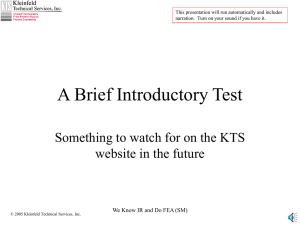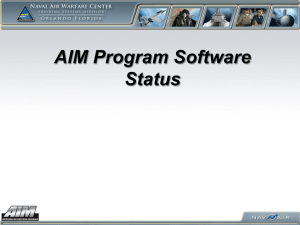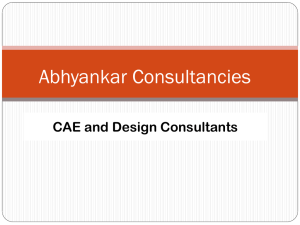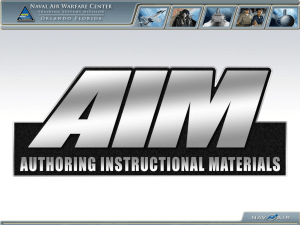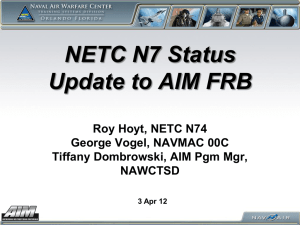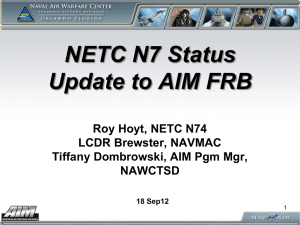NETC N72 Status Update
advertisement
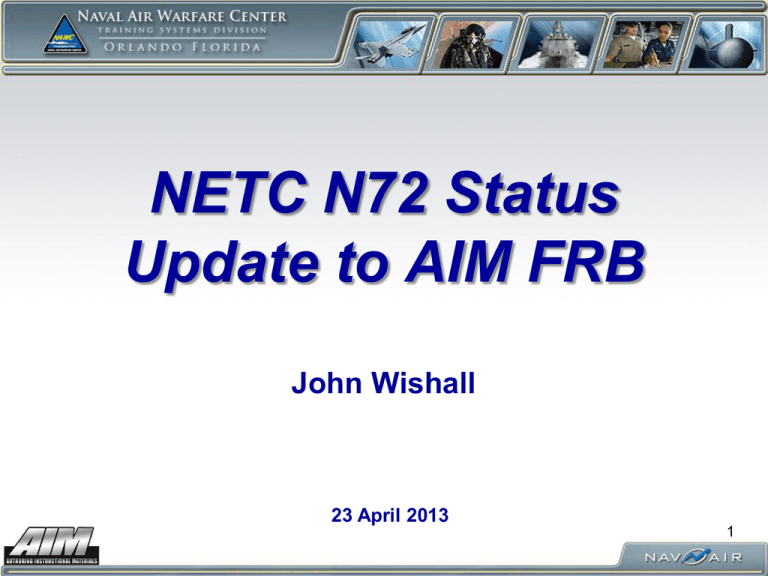
NETC N72 Status Update to AIM FRB John Wishall 23 April 2013 1 Overview • Content Project Uses CPM / AIM LO • Front End Analysis Identifies an instructional approach to teach and assess a performance requirement JDTA identify performance requirements. Has four main objectives 2 Content Project • • • • Focus on new ISD business process per NAVEDTRA 136-137-138 and 29612B DIDs. Includes context of using CPM/LO Module but not the software ‘buttonology’ taught in NAWCTSD CPM/LO Module user course Content in development with completion scheduled for 31 Oct 13 NETC N7 will sponsor convenings of this ILT course with frequency and location TBD 3 Content Course Mission Statement Participants will leave this training with sufficient knowledge to develop projects IAW NAVEDTRA and NETC guidance on the Endto-End Training Development Process. Upon completion of this course, participants will be able to develop interactive and engaging curriculum content independently following the policy/guidance to produce quality training that is at a level 2 minimum for interactivity and engagement. The desired outcome is a level of competence greater than familiarization and less than expert; sufficient to participate in project development. Work will be conducted within the NAVEDTRACOM or the larger Navy training environment for content intended to be used in Navy schools. Content Course Deliverables • 4 hours each of ILT development/blended content design and assessments on: using JDTA and 29612 DIDs to build training using FEA and 29612 DIDs to build training using Learning Objectives / Assessment Strategies and 29612 DIDs to build and evaluate training effectiveness using IMDP and 29612 DIDs to build and evaluate training effectiveness • 4 hours of how to conduct Distance Learning and Computer Aided Instruction. SAKAI and NKO 5 Front-end Analysis • • • Adaptation of mixed Excel template and CPM process now being taught by NETC N72 in period Norfolk area and DCObased 1-day course Table of Specifications (TOS) to better define Assessment Strategy Full support for FEA in CPM tasked and funded by NETC N7/NAWCTSD with delivery scheduled for early 2014 6 JDTA to FEA Transition • • • From the work (performance) to training, it is all about the data. Using the correct data to make instructional decisions. Ensuring that the data can be logically linked to support performance, directly supporting and indirectly supporting foundational /background skills and knowledge. Ensuring the approved requirement has a proper assessment strategy and the correct instructional media is identified. 7 Lessons Learned (What we see) • FEA based on indirectly supporting knowledge, since this was the only thing defined during the JDTA process. • Media mismatches • – Design documents that call for LVL III interactivity with KPL1 learning objectives. • 540 minutes of high-def video to layout scenarios • Courses that take the ‘As-Is’ and compare it to the ‘ToBe’ at the most superficial levels • A performance based objective assessed using T/F (or even multiple choice (okay, maybe in some cases) • Lack of understanding of ISD and a systematic approach to training development Lessons Learned (What’s going right) An FEA … • that is worked from a team approach with open and honest communication about the issues • that address performance, directly supporting and indirectly supporting skills and knowledge at the defined/correct proficiency level • that provides a solid base for your instructional recommendation & assessment strategy • provides the BCA three solid Courses of Action • And since we are the training experts, we should identify the risk or devise the strategy that meets the requirements based on the resources provided Lessons Learned (the future) An FEA … • Should ensure the assessment strategy and numbers of practice problems are appropriate • Should show levels of training effectiveness and projected skill/knowledge decay rate • Should connect formal training, rate-training manuals and PQS together (when appropriate) to ensure consistency in the training continuum. • Project Management is the connection point between JDTA/FEA and all follow-on courses of instruction. Since it shows the approved plan for development. • When linked with LOM, will allow for review of content being taught. Questions? 11
